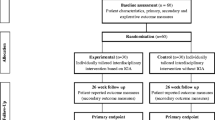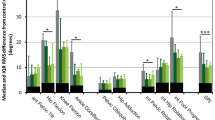Abstract
Background
While several studies have evaluated the short-term effectiveness of conservative and surgical treatment of flexed-knee gait in children with cerebral palsy (CP), few have explored the long-term outcomes using gait analysis. The purpose of this study was to examine, through gait analysis, the 10-year outcomes of flexed-knee gait in children with CP.
Methods
Ninety-seven children with spastic CP who walked with a flexed-knee gait underwent two gait evaluations [age 6.1 ± 2.1 and 16.2 ± 2.3 years, Gross Motor Function Classification System (GMFCS) I (12), II (45), III (37), IV (3)]. Limbs with knee flexion at initial contact >15° were considered walking with a flexed-knee gait and were included in the study (n = 185). Kinematic data were collected using an eight-camera motion analysis system (Motion Analysis, Santa Rosa, CA). Surgical and therapeutic interventions were not controlled.
Results
A comparison between the two gait studies showed an overall improvement in gait at 10 years follow-up. Significant improvements were seen in knee flexion at initial contact, Gait Deviation Index (GDI), Gross Motor Function Measure (GMFM), and gait speed (P < 0.01 for all). Outcome was also evaluated based on the severity of flexed-knee gait at the initial visit, with functional skills and overall gait (GDI) improving in all groups (P < 0.01 for all). The group with a severe flexed-knee gait exhibited the most improvement, while subjects with a mild flexed-knee improved the least.
Conclusions
Children at a specialty hospital whose orthopedic care included gait analysis and multi-level surgery showed improvement of flexed-knee gait and gross motor function over a 10-year course, regardless of the initial severity.

Similar content being viewed by others
References
Temelli Y, Akalan NE (2009) Treatment approaches to flexion contractures of the knee. Acta Orthop Traumatol Turc 43:113–120
Quinby JM, Abraham A (2005) Musculoskeletal problems in cerebral palsy. Curr Paediatr 15:9–14
Arnold AS, Anderson FC, Pandy MG, Delp SL (2005) Muscular contributions to hip and knee extension during the single limb stance phase of normal gait: a framework for investigating the causes of crouch gait. J Biomech 38:2181–2189
Pontén E, Gantelius S, Lieber RL (2007) Intraoperative muscle measurements reveal a relationship between contracture formation and muscle remodeling. Muscle Nerve 36:47–54
Sutherland DH, Davids JR (1993) Common gait abnormalities of the knee in cerebral palsy. Clin Orthop Relat Res (288):139–147
Arnold AS, Liu MQ, Schwartz MH, Ounpuu S, Dias LS, Delp SL (2006) Do the hamstrings operate at increased muscle-tendon lengths and velocities after surgical lengthening? J Biomech 39:1498–1506
Rodda JM, Graham HK, Carson L, Galea MP, Wolfe R (2004) Sagittal gait patterns in spastic diplegia. J Bone Joint Surg Br 86:251–258
Wren TA, Rethlefsen S, Kay RM (2005) Prevalence of specific gait abnormalities in children with cerebral palsy: influence of cerebral palsy subtype, age, and previous surgery. J Pediatr Orthop 25:79–83
Sutherland DH, Olshen R, Cooper L, Woo SL (1980) The development of mature gait. J Bone Joint Surg Am 62:336–353
Hicks JL, Schwartz MH, Arnold AS, Delp SL (2008) Crouched postures reduce the capacity of muscles to extend the hip and knee during the single-limb stance phase of gait. J Biomech 41:960–967
Bell KJ, Ounpuu S, DeLuca PA, Romness MJ (2002) Natural progression of gait in children with cerebral palsy. J Pediatr Orthop 22:677–682
Sutherland DH, Cooper L (1978) The pathomechanics of progressive crouch gait in spastic diplegia. Orthop Clin North Am 9:143–154
Rose GE, Lightbody KA, Ferguson RG, Walsh JC, Robb JE (2010) Natural history of flexed knee gait in diplegic cerebral palsy evaluated by gait analysis in children who have not had surgery. Gait Posture 31:351–354
Miller F, Browne E (2005) Cerebral palsy. Springer, New York
van den Hecke A, Malghem C, Renders A, Detrembleur C, Palumbo S, Lejeune TM (2007) Mechanical work, energetic cost, and gait efficiency in children with cerebral palsy. J Pediatr Orthop 27:643–647
Rang M, Silver R, de la Garza J (1986) Cerebral palsy. In: Lovell WW, Winter RB (eds) Pediatric orthopaedics, 2nd edn, vol. 1. JB Lippincott, Philadelphia, pp 345–396
Graham HK, Baker R, Dobson F, Morris ME (2005) Multilevel orthopaedic surgery in group IV spastic hemiplegia. J Bone Joint Surg Br 87:548–555
Rodda JM, Graham HK, Nattrass GR, Galea MP, Baker R, Wolfe R (2006) Correction of severe crouch gait in patients with spastic diplegia with use of multilevel orthopaedic surgery. J Bone Joint Surg Am 88:2653–2664
Chang WN, Tsirikos AI, Miller F, Lennon N, Schuyler J, Kerstetter L, Glutting J (2004) Distal hamstring lengthening in ambulatory children with cerebral palsy: primary versus revision procedures. Gait Posture 19:298–304
DeLuca PA, Ounpuu S, Davis RB, Walsh JH (1998) Effect of hamstring and psoas lengthening on pelvic tilt in patients with spastic diplegic cerebral palsy. J Pediatr Orthop 18:712–718
Park MS, Chung CY, Lee SH, Choi IH, Cho TJ, Yoo WJ, Park BS, Lee KM (2009) Effects of distal hamstring lengthening on sagittal motion in patients with diplegia: hamstring length and its clinical use. Gait Posture 30:487–491
Carney BT, Oeffinger D, Meo AM (2006) Sagittal knee kinematics after hamstring lengthening. J Pediatr Orthop B 15:348–350
Stout JL, Gage JR, Schwartz MH, Novacheck TF (2008) Distal femoral extension osteotomy and patellar tendon advancement to treat persistent crouch gait in cerebral palsy. J Bone Joint Surg Am 90:2470–2484
de Morais Filho MC, Neves DL, Abreu FP, Juliano Y, Guimarães L (2008) Treatment of fixed knee flexion deformity and crouch gait using distal femur extension osteotomy in cerebral palsy. J Child Orthop 2:37–43
Joseph B, Reddy K, Varghese RA, Shah H, Doddabasappa SN (2010) Management of severe crouch gait in children and adolescents with cerebral palsy. J Pediatr Orthop 30:832–839
Rozumalski A, Schwartz MH (2011) The GDI-Kinetic: a new index for quantifying kinetic deviations from normal gait. Gait Posture 33:730–732
Molloy M, McDowell BC, Kerr C, Cosgrove AP (2010) Further evidence of validity of the Gait Deviation Index. Gait Posture 31:479–482
Schwartz MH, Rozumalski A (2008) The Gait Deviation Index: a new comprehensive index of gait pathology. Gait Posture 28:351–357
Russell DJ, Rosenbaum PL, Avery LM, Lane M (2002) Gross Motor Function Measure (GMFM-66 and GMFM-88) user’s manual (clinics in developmental medicine no. 159). MacKeith Press, London
Lundkvist Josenby A, Jarnlo GB, Gummesson C, Nordmark E (2009) Longitudinal construct validity of the GMFM-88 total score and goal total score and the GMFM-66 score in a 5-year follow-up study. Phys Ther 89:342–350
Brunton LK, Bartlett DJ (2011) Validity and reliability of two abbreviated versions of the Gross Motor Function Measure. Phys Ther 91:577–588
Bleck EE (1987) Orthopaedic management in cerebral palsy. Cambridge University Press, Cambridge
Novacheck TF, Stout JL, Gage JR, Schwartz MH (2009) Distal femoral extension osteotomy and patellar tendon advancement to treat persistent crouch gait in cerebral palsy. Surgical technique. J Bone Joint Surg Am 91(Suppl 2):271–286
Conflict of interest
None.
Author information
Authors and Affiliations
Corresponding author
About this article
Cite this article
Haumont, T., Church, C., Hager, S. et al. Flexed-knee gait in children with cerebral palsy: a 10-year follow-up study. J Child Orthop 7, 435–443 (2013). https://doi.org/10.1007/s11832-013-0505-8
Received:
Accepted:
Published:
Issue Date:
DOI: https://doi.org/10.1007/s11832-013-0505-8




